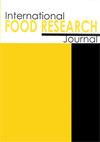Evaluation of pesticide residues in selected vegetables from Kuala Lumpur, Malaysia using modified QuEChERS and assessment of washing methods
IF 1
4区 农林科学
Q4 FOOD SCIENCE & TECHNOLOGY
引用次数: 0
Abstract
Growing population in Malaysia has resulted in increased production of local vegetables as well as pesticide usage. This constitutes a health risk to human health. In the present work, the level of ten pesticide residues namely chlorpyrifos, profenofos, aldrin, endrin, cypermethrin, lambda-cyhalothrin, carbendazim, propamocarb, imidacloprid, and thiamethoxam in ten types of vegetables collected from six local markets were measured using modified QuEChERS (quick, easy, cheap, effective, rugged, and safe) coupled with gas chromatography-tandem mass spectrometry (GC-MS/MS) and ultra-performance liquid chromatography-tandem mass spectrometry (UPLC-MS/MS). Results showed that 13.3% samples contained pesticide residues above the maximum residue limit (MRL) prescribed by the Malaysian Food Regulations 1985, 55.0% of samples contained pesticide residues below the MRL, and no pesticide residues were detected in 31.7% of samples. Carbendazim and chlorpyrifos were among the highest pesticides detected in the samples. For the type of vegetables, kale and spinach contained high concentrations of pesticide residues above the MRL. In order to produce safe vegetables, the efficiency of different washing methods (tap water, 10% sodium bicarbonate solution, and 10% acetic acid solution) in reducing carbendazim and chlorpyrifos residues in a kale model system was evaluated. Results showed that the levels of carbendazim and chlorpyrifos reduction for all three methods were significantly different (p < 0.05) with 10% acetic acid solution being the most effective followed by 10% sodium bicarbonate solution, and tap water. Washing kale with 10% acetic acid reduced 76.0 and 41.2% of carbendazim and chlorpyrifos, respectively. Therefore, it is recommended for consumers to practice 10% sodium bicarbonate washing method by soaking vegetables with an acidic solution followed by rinsing with tap water to reduce pesticide residues, and minimise the exposure to hazardous pesticides.使用改良的QuEChERS对马来西亚吉隆坡部分蔬菜的农药残留进行评估,并对清洗方法进行评估
马来西亚人口的增长导致了当地蔬菜产量的增加以及农药的使用。这对人类健康构成了健康风险。采用快速、简便、廉价、高效、安全的改良QuEChERS联合气相色谱-串联质谱(GC-MS/MS)和超高效液相色谱-串联质谱(UPLC-MS/MS)技术,对采自6个地方市场的10种蔬菜中毒死蜱、丙烯氰菊酯、丙烯氰菊酯、多菌灵、丙胺虫腈、吡虫啉、噻虫嗪等10种农药的残留量进行了测定。结果表明,13.3%的样品中农药残留超过马来西亚1985年食品法规规定的最大残留限量(MRL), 55.0%的样品中农药残留低于MRL, 31.7%的样品中未检出农药残留。多菌灵和毒死蜱是样本中含量最高的农药。对于这类蔬菜,羽衣甘蓝和菠菜的农药残留浓度高于最大残留限量。为了生产安全的蔬菜,研究了不同水洗方法(自来水、10%碳酸氢钠溶液和10%醋酸溶液)对羽衣甘蓝模型体系中多菌灵和毒死蜱残留的去除效果。结果表明,三种方法对多菌灵和毒死蜱的还原效果差异有统计学意义(p <0.05),其中10%醋酸溶液效果最好,其次是10%碳酸氢钠溶液,最后是自来水。用10%乙酸洗涤羽衣甘蓝,对多菌灵和毒死蜱的处理效果分别为76.0和41.2%。因此,建议消费者采用10%碳酸氢钠的洗涤方法,用酸性溶液浸泡蔬菜,然后用自来水冲洗,以减少农药残留,并尽量减少接触有害农药。
本文章由计算机程序翻译,如有差异,请以英文原文为准。
求助全文
约1分钟内获得全文
求助全文
来源期刊

international food research journal
Agricultural and Biological Sciences-Food Science
CiteScore
1.40
自引率
0.00%
发文量
75
期刊介绍:
The International Food Research Journal (IFRJ) publishes papers in English, six (6) issues a year with the coverage of:
Food Science and Technology
Nutrition and Dietetics
Agriculture, multidisciplinary
Chemistry, multidisciplinary
The scope of the Journal includes:
Food Science, Food Technology and Food Biotechnology
Product Development and Sensory Evaluation
Food Habits, Nutrition, and Health
Food Safety and Quality
Food Chemistry, Food Microbiology, Food Analysis and Testing
Food Engineering
Food Packaging
Food Waste Management
Food Entrepreneur
Food Regulatory
Post-Harvest Food Management
Food Supply Chain Management
Halal Food and Management
 求助内容:
求助内容: 应助结果提醒方式:
应助结果提醒方式:


